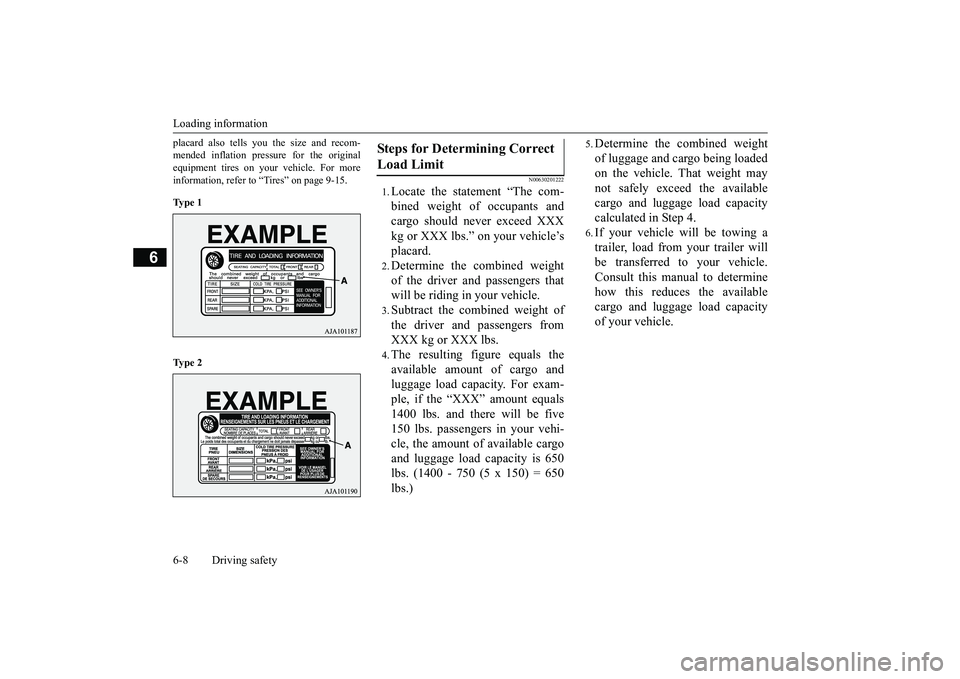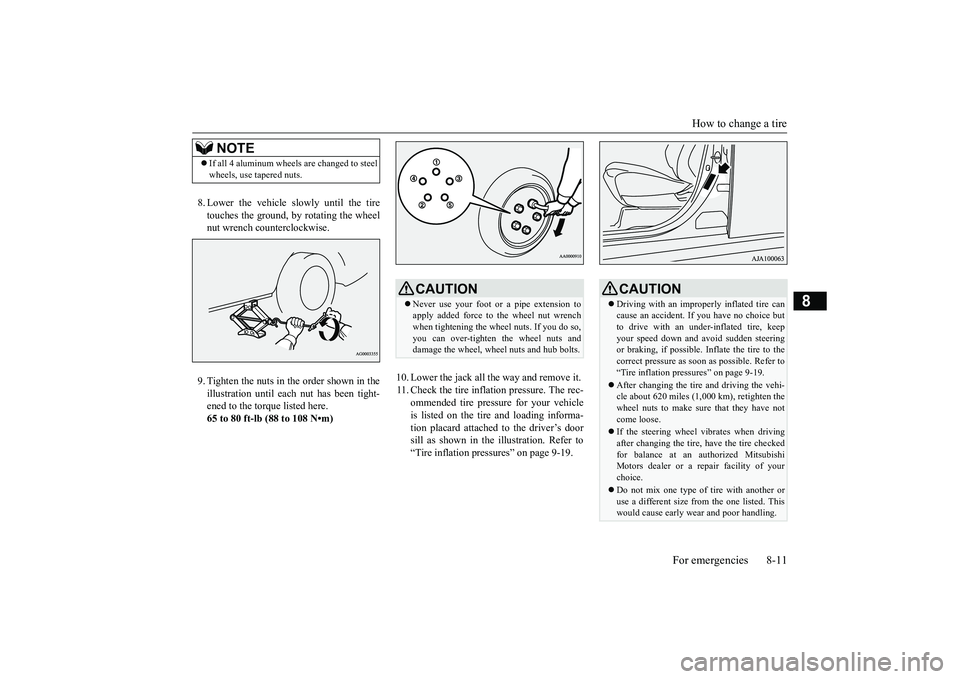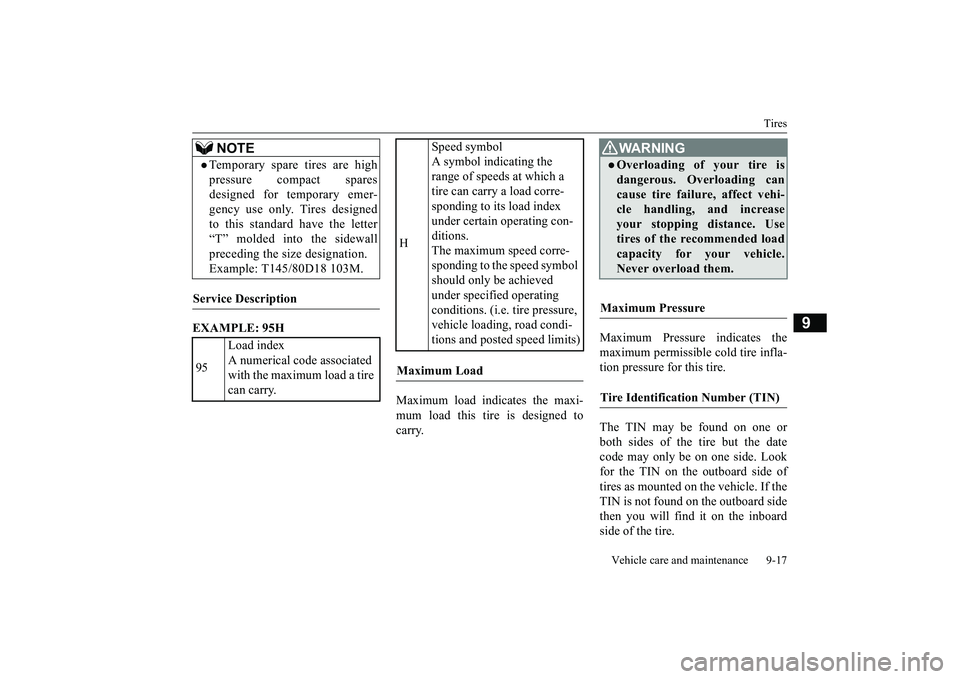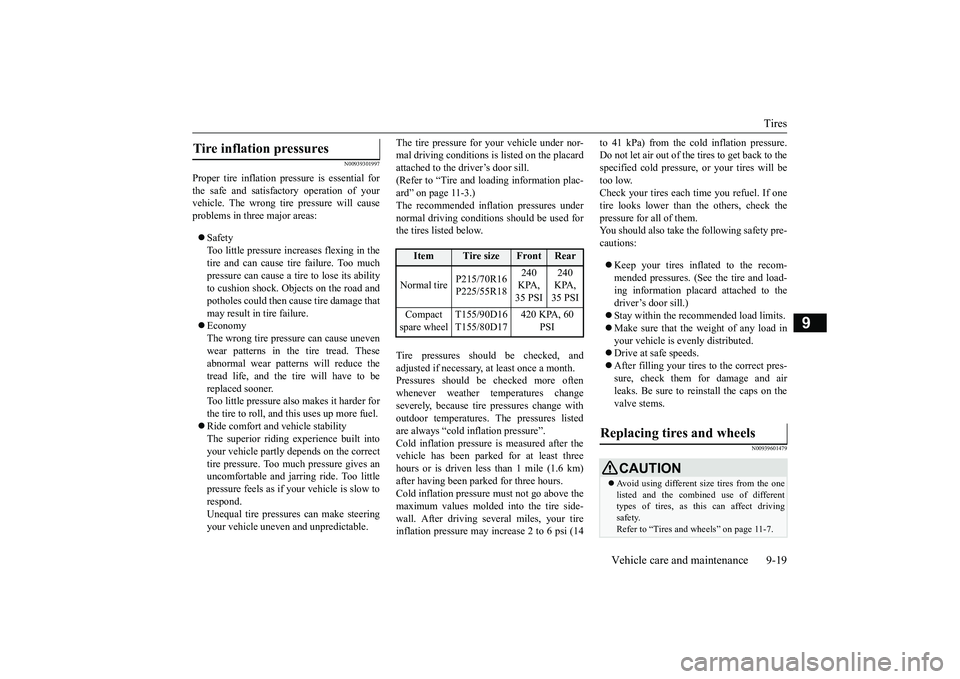2018 MITSUBISHI OUTLANDER III tire size
[x] Cancel search: tire sizePage 207 of 441

Blind Spot Warning (BSW) (with Lane Change Assist) (if so equipped)
5-126 Features and controls
5
N00592200040
The Blind Spot Warning (BSW) is a driving
aid system that alerts the driver when another
vehicle which may not be visible through the
outside rearview mirror is traveling in the
next lane behind your vehicle.
When a vehicle in the next lane is traveling at
same speed or faster in the detection areas,
the Blind Spot Warning light in the corre-
sponding outside rearview mirror will illumi-
nate. If the turn signal lever is operated to the
side where the Blind Spot Warning light is
illuminated, the Blind Spot Warning light will
blink and the system will beep three times to
alert the driver.
• Do not put anything including a sticker or
film to the outer side of the windshield in
front of or surrounding area of the sensor.
Also, do not put anything including a
sticker or film to the inner side of the wind-
shield under the sensor.• Do not attempt to deta ch or disassemble the
sensor.• If the windshield is misted, remove the mist from the windshield by using the defogger
switch.• Maintain the wiper blades in good condi- tion. Refer to “Wiper blades” on page 9-44.
When replacing the wiper blades, use only
Mitsubishi Motors Genuine parts or equiva-
lent.• Do not dirty or damage the sensor.• Do not spray glass cleaner on the sensor.Also, do not spill liquid, such as a bever-
age, to the sensor.• Do not install an elec tronic device, such as
antenna, or a device that emits strong elec-
tric waves, near the sensor.CAUTION
• Always use tires of the same size, same
type and same brand, and which have no
significant wear differences.• Do not modify the vehicle’s suspensions. If the windshield on the sensor or in the sur-
rounding area of the sensor is cracked or
scratched, the sensor may not detect an
object properly. This could cause a serious
accident. Turn off the FCM and have your
vehicle inspected as soon as possible at an
authorized Mitsubishi Motors dealer.
If you need to replace the windshield, con-
tact an authorized Mitsubishi Motors dealer. The sensor emits infrared rays when the
operation mode is in ON. Do not look into
the sensor by using optical goods such as a
magnifying glass. The infrared ray might
injure your eyes.Laser radar specifications
Laser classificationMax average power 45 mWPulse duration 33 nsWavelength905 nmDivergent angle
(horizon x vertical)28° x 12°
CAUTION
Laser classification labelBlind Spot Warning (BSW)
(with Lane Change Assist)
(if
so equipped)
BK0249100US.book 126 ページ 2017年5月10日 水曜日 午前8時49分
Page 220 of 441

Tire pressure monitoring system
Features and controls 5-139
5
Each tire, including the spare (if provided),should be checked monthly when cold andinflated to the inflation pressure recom-mended by the vehicle manufacturer on thevehicle placard or tire
inflation pressure label.
(If your vehicle has tires of a different sizethan the size indicated on the vehicle placardor tire inflation pressure label, you shoulddetermine the proper ti
re inflation pressure
for those tires.)As an added safety feat
ure, your vehicle has
been equipped with a tire pressure monitoringsystem (TPMS) that illuminates a low tirepressure telltale when
one or more of your
tires is significantly under-inflated.Accordingly, when the low tire pressure tell-tale illuminates, you
should stop and check
your tires as soon as possible, and inflatethem to the proper pressure. Driving on a sig-nificantly under-inflated
tire causes the tire to
overheat and can lead
to tire failure.
Under-inflation also reduces fuel efficiencyand tire tread life, and may affect the vehi-cle’s handling and stoppi
ng ability. Please
note that the TPMS is
not a substitute for
proper tire maintenance, and it is the driver’sresponsibility to
maintain corre
ct tire pres-
sure, even if under-infl
ation has not reached
the level to trigger illumination of the TPMSlow tire pressure telltale.Your vehicle has also
been equipped with a
TPMS malfunction indica
tor to indicate when
the system is not operating properly. TheTPMS malfunction indicator is combinedwith the low tire pressure telltale.When the system detects a malfunction, thetelltale will flash for approximately one min-ute and then remain c
ontinuously illuminated.
This sequence will c
ontinue upon subsequent
vehicle start-ups as long as the malfunctionexists.When the malfunction indicator is illumi-nated, the system may not
be able to detect or
signal low tire pr
essure as intended.
TPMS malfunctions ma
y occur for a variety
of reasons, including the installation ofreplacement or alternate tires or wheels on thevehicle that prevent the TPMS from function-ing properly. Always
check the TPMS mal-
function telltale after
replacing one or more
tires or wheels on your vehicle to ensure thatthe replacement or alternate tires and wheels
CAUTIONIf the tire pressure monitoring system warn-ing light does not illumi
nate when the igni-
tion switch is turned to the “ON” position orthe operation mode is put in ON, it meansthat the tire pressure monitoring system isnot working properly. Have the systeminspected by an authorized MitsubishiMotors dealer.In such situations, a malfunctioning of thesystem may be preventing the monitoring ofthe tire pressure. Avoid sudden braking,sharp turning and high-speed driving.If a malfunction is detected in the tire pres-sure monitoring system, the tire pressuremonitoring system warning light will blinkfor approximately 1 mi
nute and then remain
continuously illuminate
d. The warning light
will issue further warnings each time theengine is restarted as
long as the malfunction
exists.Check to see whether the warning light goesoff after few minutes driving.If it then goes off during driving, there is noproblem.However, if the warning light does not gooff, or if it blinks again when the engine isrestarted, have the
vehicle inspected by an
authorized Mitsubish
i Motors dealer.
In such situations, a malfunctioning of thesystem may be preventing the monitoring ofthe tire pressure. For safety reasons, whenthe warning light appears while driving,avoid sudden braking, sharp turning andhigh-speed driving.
NOTE
In addition, the warni
ng display is displayed
on the information screen in the multi-infor-mation display.
BK0249100US.book 139 ページ 2017年5月10日 水曜日 午前8時49分
Page 337 of 441

Loading information6-8 Driving safety
6
placard also tells you the size and recom-mended inflation pressure for the originalequipment tires on your vehicle. For moreinformation, refer to “Tires” on page 9-15.Ty p e 1Ty p e 2
N00630201222
1.Locate the statement “The com-bined weight of occupants andcargo should never exceed XXXkg or XXX lbs.” on your vehicle’splacard.2.Determine the combined weightof the driver and passengers thatwill be riding in your vehicle.3.Subtract the combined weight ofthe driver and passengers fromXXX kg or XXX lbs.4.The resulting figure equals theavailable amount of cargo andluggage load capacity. For exam-ple, if the “XXX” amount equals1400 lbs. and there will be five150 lbs. passengers in your vehi-cle, the amount of available cargoand luggage load
capacity is 650
lbs. (1400 - 750 (5 x 150) = 650lbs.)
5.Determine the combined weightof luggage and cargo being loadedon the vehicle. That weight maynot safely exceed the availablecargo and luggage load capacitycalculated in Step 4.6.If your vehicle will be towing atrailer, load from your trailer willbe transferred to your vehicle.Consult this manual to determinehow this reduces the availablecargo and luggage load capacityof your vehicle.
Steps for Determining Correct Load Limit
BK0249100US.book 8 ページ 2017年5月10日 水曜日 午前8時49分
Page 372 of 441

How to change a tire
For emergencies 8-11
8
8. Lower the vehicle slowly until the tiretouches the ground, by rotating the wheelnut wrench counterclockwise.9. Tighten the nuts in the order shown in theillustration until each
nut has been tight-
ened to the torque listed here.65 to 80 ft-lb (88 to 108 N•m)
10. Lower the jack all the way and remove it.11. Check the tire inflation pressure. The rec-
ommended tire pressure for your vehicleis listed on the tire
and loading informa-
tion placard attached to the driver’s doorsill as shown in the illustration. Refer to“Tire inflation pressures” on page 9-19.
NOTE
If all 4 aluminum wheels are changed to steelwheels, use tapered nuts.
CAUTIONNever use your foot or a pipe extension toapply added force to the wheel nut wrenchwhen tightening the wheel nuts. If you do so,you can over-tighten the wheel nuts anddamage the wheel, wheel nuts and hub bolts.
CAUTIONDriving with an imprope
rly inflated tire can
cause an accident. If
you have no choice but
to drive with an under-inflated tire, keepyour speed down and avoid sudden steeringor braking, if possible. Inflate the tire to thecorrect pressure as s
oon as possible. Refer to
“Tire inflation pressures” on page 9-19.After changing the tire
and driving the vehi-
cle about 620 miles (1,000 km), retighten thewheel nuts to make sure
that they have not
come loose.If the steering wheel vibrates when drivingafter changing the tire, have the tire checkedfor balance at an authorized MitsubishiMotors dealer or a repair facility of yourchoice.Do not mix one type of tire with another oruse a different size from the one listed. Thiswould cause ea
rly wear and poor handling.
BK0249100US.book 11 ページ 2017年5月10日 水曜日 午前8時49分
Page 393 of 441

Tires9-16 Vehicle care and maintenance
9
Ply: a layer of r
ubber-coated parallel
cords.Cord: the strands forming the plies in thetire.Rim: a metal support for a tire or a tireand tube assembly upon which the tirebeads are seated.Rim diameter: nominal diameter of thebead seat.Groove: the space between two adjacenttread ribs.
EXAMPLE: P215/65R15
Tire Markings 1- Size Designation2- Service Description3- Maximum Load4- Maximum Pressure5- U.S. DOT Safety Standards
Code (TIN)
6- Treadwear, Traction and Tem-
perature Grades
Size Designation P
Passenger car tire size based on U.S.A. design standards
215
Section width in millimeters (mm)
65
Aspect ratio in percent (%)Ratio of section height to sec-tion width of tire.
R
Construction code •“R” means radial construc-tion. •“D” means diagonal or bias construction.
15 Rim diameter in inches (in)
NOTE
European/Japanese metric tiresizing is based on European/Jap-anese design standards. Tiresdesigned to these standards havethe tire size molded into thesidewall beginning with the sec-tion width. The letter “P” isabsent from this tire size desig-nation.Example: 215/65R15 96H.LT (Light Truck) -metric tiresizing is based on U.S.A. designstandards. The size designationfor LT-metric tires is the same asfor P-metric tires except for theletters “LT” that are molded intothe sidewall preceding the sizedesignation.Example: LT235/85R16.
BK0249100US.book 16 ページ 2017年5月10日 水曜日 午前8時49分
Page 394 of 441

Tires
Vehicle care and maintenance 9-17
9
EXAMPLE: 95H
Maximum load indicates the maxi-mum load this tire is designed tocarry.
Maximum Pressure indicates themaximum permissible cold tire infla-tion pressure for this tire.The TIN may be found on one orboth sides of the tire but the datecode may only be on one side. Lookfor the TIN on the outboard side oftires as mounted on the vehicle. If theTIN is not found on the outboard sidethen you will find it on the inboardside of the tire.
Temporary spare tires are highpressure compact sparesdesigned for temporary emer-gency use only. Tires designedto this standard have the letter“T” molded into the sidewallpreceding the size
designation.
Example: T145/80D18 103M.
Service Description 95
Load indexA numerical code associated with the maximum load a tire can carry.NOTE
H
Speed symbolA symbol indicating the range of speeds at which a tire can carry a load corre-sponding to its load index under certain operating con-ditions.The maximum speed corre-sponding to the speed symbol should only be achieved under specified operating conditions. (i.e. tire pressure, vehicle loading, road condi-tions and posted speed limits)
Maximum Load
WA R N I N GOverloading of your tire isdangerous. Overloading cancause tire failure, affect vehi-cle handling, and increaseyour stopping distance. Usetires of the recommended loadcapacity for your vehicle.Never overload them.
Maximum Pressure Tire Identification Number (TIN)
BK0249100US.book 17 ページ 2017年5月10日 水曜日 午前8時49分
Page 395 of 441

Tires9-18 Vehicle care and maintenance
9
EXAMPLE: DOT MA L9 ABCD 1504
The treadwear grade is a comparativerating based on the wear rate of thetire when tested under controlledconditions on a specified governmenttest course. For example, a tiregraded 150 would wear one and one-half (1
1/2) times as well on the gov-
ernment course as a tire graded 100.The relative performance of tiresdepends upon the
actual conditions
of their use, however, and may departsignificantly from the norm due tovariations in driv
ing habits, service
practices and differences in roadcharacteristics and climate.The traction grades, from highest tolowest, are AA, A, B and C. Thosegrades represent the tire’s ability tostop on wet pavement as measured
under controlled co
nditions on speci-
fied government test surfaces ofasphalt and concrete. A tire markedC may have poor traction perfor-mance.The temperature grades are A (thehighest), B and C, representing thetire’s resistance to the generation ofheat and its ability to dissipate heatwhen tested under controlled condi-tions on a specified indoor laboratorytest wheel. Sustained high tempera-ture can cause the material of the tireto degenerate and reduce tire life, andexcessive temperature can lead tosudden tire failure. The grade C cor-responds to a level of performancewhich all passenger car tires mustmeet under the Federal Motor Vehi-cle Safety Standard No. 109. GradesB and A represent higher levels ofperformance on the laboratory testwheel than the minimum required bylaw.
DOT
Department of Transporta-tionThis symbol certifies that the tire is in compliance with the U.S. Department of Transportation tire safety standards, and is approved for highway use.
MA
Code representing the tire manufacturing location. (2 digits)
L9ABCD
Code representing the tire size. (2 digits)turer. (1 to 4 digits)
15
Number representing the week in which the tire was manufactured. (2 digits)
04
Number representing the year in which the tire was manufactured. (2 digits)
Treadwear, Traction and Temper-ature Grades Tr e a d w e a rTr a c t i o n
Te m p e r a t u r e
BK0249100US.book 18 ページ 2017年5月10日 水曜日 午前8時49分
Page 396 of 441

Tires
Vehicle care and maintenance 9-19
9
N00939301997
Proper tire inflation pre
ssure is essential for
the safe and satisfac
tory operation of your
vehicle. The wrong tire pressure will causeproblems in three major areas:SafetyToo little pressure increases flexing in thetire and can cause tire failure. Too muchpressure can cause a tire to lose its abilityto cushion shock. Objects on the road andpotholes could then ca
use tire damage that
may result in tire failure.EconomyThe wrong tire pressu
re can cause uneven
wear patterns in the tire tread. Theseabnormal wear patter
ns will reduce the
tread life, and the tire will have to bereplaced sooner.Too little pressure also makes it harder forthe tire to roll, and this uses up more fuel.Ride comfort and vehicle stabilityThe superior riding e
xperience built into
your vehicle partly de
pends on the correct
tire pressure. Too much pressure gives anuncomfortable and jarring ride. Too littlepressure feels as if
your vehicle is slow to
respond.Unequal tire pressure
s can make steering
your vehicle uneven
and unpredictable.
The tire pressure for your vehicle under nor-mal driving conditions is listed on the placardattached to the driver’s door sill.(Refer to “Tire and loading information plac-ard” on page 11-3.)The recommended inflation pressures undernormal driving conditions should be used forthe tires listed below.Tire pressures should be checked, andadjusted if necessary, at least once a month.Pressures should be checked more oftenwhenever weather temperatures changeseverely, becaus
e tire pressures change with
outdoor temperatures. The pressures listedare always “cold in
flation pressure”.
Cold inflation pressure is measured after thevehicle has been parked for at least threehours or is driven less than 1 mile (1.6 km)after having been parked for three hours.Cold inflation pressure must not go above themaximum values molded into the tire side-wall. After driving several miles, your tireinflation pressure may increase 2 to 6 psi (14
to 41 kPa) from the cold inflation pressure.Do not let air out of the tires to get back to thespecified cold pressure, or your tires will betoo low.Check your tires each t
ime you refuel. If one
tire looks lower than the others, check thepressure for all of them.You should also take the following safety pre-cautions:Keep your tires inflated to the recom-mended pressures. (See the tire and load-ing information placard attached to thedriver’s door sill.)Stay within the recommended load limits.Make sure that the weight of any load inyour vehicle is evenly distributed.Drive at safe speeds.After filling your tires to the correct pres-sure, check them for damage and airleaks. Be sure to reinstall the caps on thevalve stems.
N00939601479
Tire inflation pressures
Item
Tire size
Front
Rear
Normal tire
P215/70R16P225/55R18
240 KPA, 35 PSI
240 KPA, 35 PSI
Compact spare wheel
T155/90D16T155/80D17
420 KPA, 60
PSI
Replacing tires and wheels
CAUTIONAvoid using different size tires from the onelisted and the combined use of differenttypes of tires, as this can affect drivingsafety.Refer to “Tires and wheels” on page 11-7.
BK0249100US.book 19 ページ 2017年5月10日 水曜日 午前8時49分